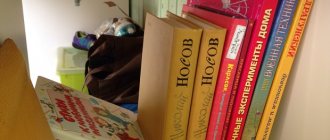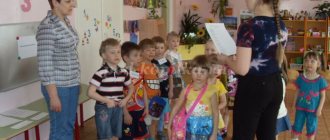Mom's helpers
Features of the game and its educational significance. This game is aimed at developing children's verbal memory. As you know, remembering words makes it more difficult for a child to remember objects. Due to the concreteness of children's thinking, it is difficult for a child to remember a word he hears without connection with its subject content. This requires special effort. This game creates conditions that, on the one hand, teach one to make such efforts, and on the other hand, facilitate them. The support for purposeful and meaningful memorization of words in this game is subject pictures and playful communication with the teacher.
The game is story-based. The teacher takes on the role of a mother who gives her children (helpers) instructions to remember and bring what they need for the house. Such a plot is very close to the everyday experience of children and satisfies their need to communicate with adults. It ensures children’s emotional involvement in the game and encourages them to take conditional play actions. It is also very important that the adult lists not separate, disparate objects, but objects united by a common playful meaning.
Meaningful and purposeful memorization of words prepares children to successfully meaningfully remember verbal instructions from an adult. And this is very important for children’s learning in the classroom and for their future lives.
Game material. Subject pictures that are selected from various board games: “Loto in four languages”, “Pictures for kids”, “Botanical summer”, etc. Pictures can depict a variety of objects, for example: fruits, vegetables, toys, flowers, clothes, dishes, etc. etc. Pictures should be selected into sets consisting of three or four similar items. The number of such sets must correspond to the number of participants in the game. It is advisable to have several sets in stock to vary orders.
The gaming material is stored in a box with special compartments for different groups of pictures.
Description of the game and methods of its implementation. The game can be played with a small subgroup of children (four to six people) or with the whole group. Let us describe a variant of the game with a small subgroup. The teacher offers to play a new game with familiar pictures. “I will be your mother, and you will be my assistants. I want to cook delicious vegetable soup for you. Vovochka, son, bring me cabbage, carrots, and potatoes for soup. Tell me again, what do I need to bring to make the soup?” Having answered the teacher’s question, the child goes to the table, where all the pictures are laid out in advance, and selects the ones he needs. Then he shows them to all the children, and they, together with the teacher, evaluate whether the assignment was completed correctly: whether he brought everything, whether he mixed up anything. Mom thanks Vova and pretends to cook some soup. “I’d like to treat you to something tasty,” she says after a while. - Go, daughter, to the store and bring us grapes, pears and oranges. Do you remember what you need to buy? The daughter goes to do her mother’s errand, and then everyone feasts on fruit.
During the game, the mother instructs her children to bring a variety of objects (three or four types), each time explaining their purpose. For example: you need to buy toys for children (a car, a doll, a bear, a ball) or dishes to set the table (a cup, a teapot, a sugar bowl), a vase of flowers for beauty, or bring what is needed to clean the room (a broom, a dustpan, a bucket with water).
Gradually, when repeating the game, you can expand the number of memorized words (up to five) and enrich the content of the connections being established, for example, a saucepan can be added to vegetables for soup, a comb or brush for cleaning clothes can be among the clothes, a jug of water can be added to fruits (to wash them), etc.
The fulfillment of all instructions is assessed by both the teacher and the children. The brought pictures are used in imaginary play activities - children pretend to cook soup, feast on fruit, play with toys, dress up for a walk, etc.
Rules of the game.
1. Carry out mom’s instructions on your own, without confusing or forgetting anything.
2. Prompting is not allowed.
3. If someone did not completely complete the order and forgot to bring something, the children remind him and he goes again for the missing item.
Tips for the teacher. All subject pictures should be familiar to children and easily recognizable. Place them in advance on the tables in rows, at some distance from each other, to make it easier for children to distinguish and select them (the pictures serve as a support for remembering the named words).
Given the difficulty of memorizing words for young children, this game should be played last, when children have already learned to establish and maintain semantic connections on other visual material.
With children who often forget words, play separately, varying the different tasks and encouraging them to complete them.
When playing with the whole group, all children take turns becoming helpers. Having two tables with playing material, you can simultaneously give instructions to two children at once. All participants in the game evaluate, together with the teacher, the correctness of carrying out mother’s instructions.
Updated: 2019-07-09 22:39:47
- games that develop memory
- mechanical assistants for mother.
- just love?
- Let's please our loved ones
- Eighteen to twenty-four months: big thoughts



